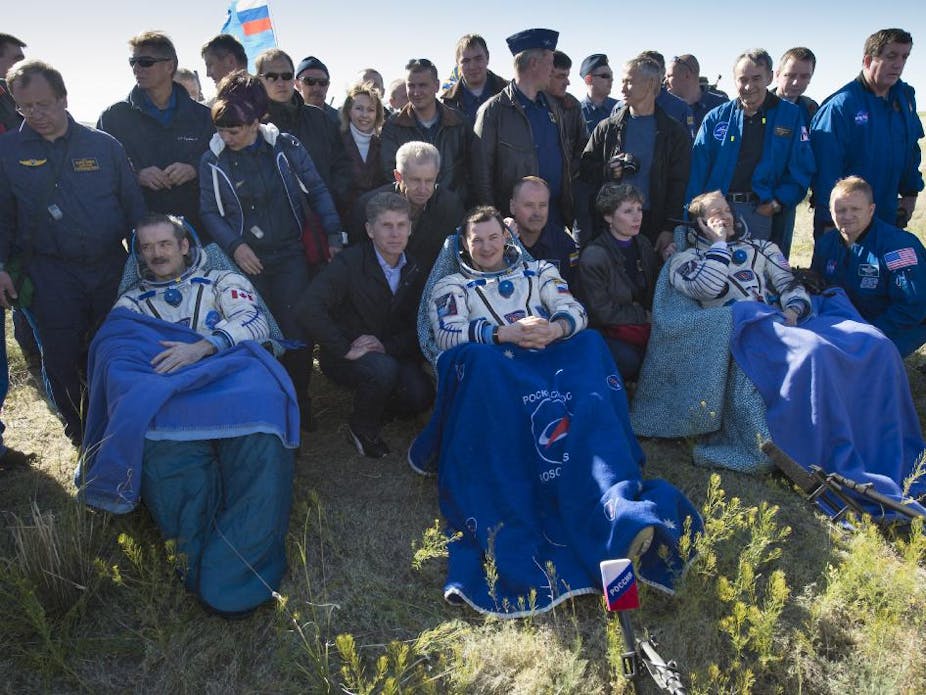Three astronauts from the International Space Station, including the singing Canadian Chris Hadfield, landed in Kazakhstan today after a journey of nearly 100 million kilometres.
Commander Hadfield, an avid Twitter-user who recently released a video of himself singing the David Bowie classic Space Oddity, joined Soyuz Commander Roman Romanenko of the Russian Federal Space Agency(Roscosmos) and NASA Flight Engineer Tom Marshburn on the long trip home from the station.
“Russian recovery teams were on hand to help the crew exit the Soyuz vehicle and adjust to gravity after 146 days in space,” NASA said in a statement on its website.
“The undocking marked the end of Expedition 35 and the start of Expedition 36 under the command of Russian cosmonaut Pavel Vinogradov, who is scheduled to remain on the station with Flight Engineers Chris Cassidy and Alexander Misurkin until September.”
NASA said Hadfield, Marshburn and Romanenko spent their last morning on the station packing, including hardware from an experiment examining how gases and liquids come together and separate in space.
“Results from this experiment may lead to improvements in the shelf-life of household products, food and medicine,” NASA said.
Making space a human place
Kevin Orrman-Rossiter, Senior Research Services Officer at the University of Melbourne’s Faculty of Science, said the International Space Station provides humans with a place to live in space.
“Until we get past a certain point that commercial interests take over and it becomes the ‘next’ exotic holiday, space exploration still requires substantial effort. In this case a multinational effort, demonstrating that people can work across political and national boundaries,” he said.
“For me, an interesting outcome from this last expedition was the difference one person made. Commander Chris Hadfield connected widely with people across the world using Twitter and fantastic pictures of our world from a view we can not normally see.”
Alice Gorman, Lecturer in Archaeology at Flinders University and an expert on space junk said the the International Space Station has many critics who see it as a white elephant.
“But I think it’s quite important for a couple of reasons - firstly because it’s an international cooperative venture, and this is an important antidote to the strong current of national security and military interests in space,” she said.
“As for the other reason, think about what it would be like if there were no humans in space at all. I think we’d feel a little closed in, like we had poked our head out of the atmosphere for a look and then scurried back in before anything scary happened.”
While robotic missions are far more efficient than crewed missions, the space station was about more than scientific efficiency, she said.
“It’s about making space a human place, and I think that’s important.”
Getting off Earth
Jonti Horner, Post Doctoral Research Fellow at University of New South Wales and an expert on exoplanets, said that the most important thing about the International Space Station is simply that it’s there.
“When we went to the Moon, in the late 60s and early 70s, it was viewed as being the first step towards a future where humanity was spreading out to the stars (manned bases on the moon, and Mars).
Since the last man walked on the moon, though, 40 years have passed - and since then, men and women have never left relatively low Earth orbit,” he said, adding that many important [experiments](http://en.wikipedia.org/wiki/Scientific_research_on_the_International_Space_Station](http://en.wikipedia.org/wiki/Scientific_research_on_the_International_Space_Station) had been done on the station, taking advantage of its microgravity conditions.
“It’s kind of important to have some manned presence up there, I feel - if nothing else, just to show we haven’t totally abandoned the idea of getting off our planet.”
Dr Danail Obreschkow, Research Associate Professor of Astronomy at the University of Western Australia, said the return of the three astronauts marked a milestone in space exploration.
“The expedition pursued a high-level research program in microgravity, intercepted by adventurous space walks outside the station to repair broken parts. An orbiting island in space, the International Space Station is a true masterpiece of human invention, making scientists and engineers hold their breath,” he said.
“But the real power of the International Space Station lies in its astonishing message to everyone. A symbol for peaceful collaboration between world powers once at war, it reminds us of how much we can achieve together. Its pictures inspire the dreams of millions of children, uncover their passion for science and convey that big visions can come true. This investment in the motivation of future generations will pay back a thousand times and make the giant costs of the International Space Station look small in comparison.”
Dr Obreschkow said it was possible to see the space station travelling across the night sky.
“It looks a bit like a star, but in motion, a bit like a plane, but not blinking. Look up your local transit times here.”

